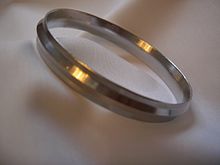A kara (Punjabi: ਕੜਾ (Gurmukhi), کڑا (Shahmukhi) कड़ा (Devanagari)) is a steel or cast iron bangle worn by Sikhs. It is not necessarily expected to be worn by only Sikhs, but it is a prevalent practice and broadly represents ones' devotion to Sikhism. Sikhism preaches the importance of equality, and having reverence for god (Waheguru) at all times, represented through the five Ks; ceremonial items worn or used by Sikhs in the practice of Sikhism, of which kara is one.[1]

History
editThe kara was instituted by the tenth Sikh guru Gobind Singh at the Baisakhi Amrit Sanchar in 1699. Guru Gobind Singh explained:
He does not recognize anyone else except me, not even the bestowal of charities, the performance of merciful acts, austerities, and restraint on pilgrim-stations; the perfect light of the Lord illuminates his heart, then consider him as the immaculate Khalsa.
— Guru Gobind Singh[2]
Meaning and usage
editTheology
editThe Kara is a symbol of unbreakable attachment and commitment to God. As the Sikhs' holy text the Guru Granth Sahib says "In the tenth month, you were made into a human being, O my merchant friend, and you were given your allotted time to perform good deeds."[3] Similarly, Bhagat Kabir reminds the Sikh to always keep one's consciousness with God: "With your hands and feet, do all your work, but let your consciousness remain with the Immaculate Lord."[4] The kara is also worn by many Sikhs and other non-Sikh Indian families across the states in the North, North-West and West of India (such as Gujarat, Rajasthan, and even Maharashtra) by Hindus.[5]
Combat
editIt was also historically used like a knuckle-duster for hand-to-hand combat. Battlefield variations include kara with spikes or sharp edges. Sikh soldiers serving for the British army in India would settle disputes by competing in a form of boxing known as loh-muthi (lit. iron fist) with a kara on one hand. Loh-Muthi is a historic form of Musti-yuddha.
Controversies
editIndia
editIn 2022, a Sikh lady candidate, Manharleen Kaur was barred from taking a competitive examination by the Delhi Subordinate Services Selection Board (DSSSB) until she removed her metallic Kara, despite arriving at the examination site before the closing time.[6] Kaur later filled a case against DSSSB in Delhi High Court for the denial of permission to her to appear in examination. DSSSB informed court that "Sikh candidates are allowed to appear in examinations with metallic kara (bangle) or kirpan (dagger) subject to their reaching the centre at least one hour before the reporting time" and a notice was sent to Kaur informing the above guidelines but Kaur argued that "such notification was notified only two days after the examination was held." After hearing the petitioner, the court directed DSSSB "to ensure that adequate notice, which is well in advance, is given concerning the additional requirement to reach the examination centre one hour before the reporting time in case a candidate is wearing a kara and/or kirpan so that no undue hardship is caused to them."[7]
United Kingdom
editIn November 2007, a 14 year old Sikh girl, Sarika Singh was excluded from Aberdare Girls' School in South Wales for wearing a Kara as the "school has banned students from wearing any jewellery other than plain ear studs and wrist watches."[8] In July 2008, Judge Stephen Silber of the High Court of England and Wales said that "the bangle - known as the kara - was a symbol of her Sikh faith and not a piece of jewellery". He further said that "the school is guilty of indirect discrimination under race relations and equality laws" and Singh was allowed to return to school wearing her Kara in September 2008.[9]
In 2017, 8 year old Kaiden Singh was banned from wearing a kara to school in Tipton, England.[10]
See also
editReferences
edit- ^ "BBC - Religions - Sikhism: The Five Ks". BBC.co.uk. BBC Online. 29 September 2009. Archived from the original on 16 January 2024. Retrieved 19 February 2024.
- ^ Guru Gobind Singh. Dasam Granth. p. 1350.
- ^ Guru Granth Sahib. p. 76.
- ^ Kabir. Guru Granth Sahib. p. 1376.
- ^ Dhooleka Sarhadi Raj (25 August 2003). Where are you from?: middle-class migrants in the modern world. University of California Press. ISBN 9780520928671. Archived from the original on 19 February 2024. Retrieved 17 December 2011.
Individual Sikhs and Hindus share symbols and practices of body inscription (such as wearing a kara and women keeping their hair long).
- ^ "Sikhs wearing kara/kirpan to be allowed to take DSSSB exam if they reach 1 hr before time, HC told". The Economic Times. Press Trust of India. 7 October 2022. Archived from the original on 2024-02-20. Retrieved 2024-02-20.
- ^ "Sikh woman prevented from appearing in exam for wearing kara". Telegraph India. Press Trust of India. 12 July 2022. Archived from the original on 2022-07-14. Retrieved 2024-02-20.
- ^ MacLeod, Donald (23 January 2008). "Excluded Sikh pupil goes to court over religious bangle ban". The Guardian. Archived from the original on 9 March 2020. Retrieved 19 February 2024.
- ^ "UK: Sikh girls wins legal battle". Rediff.com. Press Trust of India. 29 July 2008. Archived from the original on 6 August 2008. Retrieved 19 February 2024.
- ^ "British Sikh Boy Banned From Wearing Kara To School". NDTV.com. Press Trust of India. 3 October 2017. Archived from the original on 12 August 2019. Retrieved 19 February 2024.